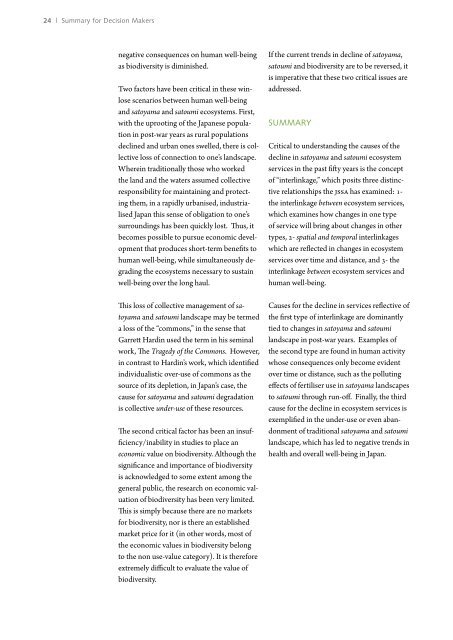Satoyama-Satoumi Ecosystems and Human Well-Being - UNU-IAS ...
Satoyama-Satoumi Ecosystems and Human Well-Being - UNU-IAS ...
Satoyama-Satoumi Ecosystems and Human Well-Being - UNU-IAS ...
Create successful ePaper yourself
Turn your PDF publications into a flip-book with our unique Google optimized e-Paper software.
24 | Summary for Decision Makers<br />
negative consequences on human well-being<br />
as biodiversity is diminished.<br />
Two factors have been critical in these winlose<br />
scenarios between human well-being<br />
<strong>and</strong> satoyama <strong>and</strong> satoumi ecosystems. First,<br />
with the uprooting of the Japanese population<br />
in post-war years as rural populations<br />
declined <strong>and</strong> urban ones swelled, there is collective<br />
loss of connection to one’s l<strong>and</strong>scape.<br />
Wherein traditionally those who worked<br />
the l<strong>and</strong> <strong>and</strong> the waters assumed collective<br />
responsibility for maintaining <strong>and</strong> protecting<br />
them, in a rapidly urbanised, industrialised<br />
Japan this sense of obligation to one’s<br />
surroundings has been quickly lost. Thus, it<br />
becomes possible to pursue economic development<br />
that produces short-term benefits to<br />
human well-being, while simultaneously degrading<br />
the ecosystems necessary to sustain<br />
well-being over the long haul.<br />
This loss of collective management of satoyama<br />
<strong>and</strong> satoumi l<strong>and</strong>scape may be termed<br />
a loss of the “commons,” in the sense that<br />
Garrett Hardin used the term in his seminal<br />
work, The Tragedy of the Commons. However,<br />
in contrast to Hardin’s work, which identified<br />
individualistic over-use of commons as the<br />
source of its depletion, in Japan’s case, the<br />
cause for satoyama <strong>and</strong> satoumi degradation<br />
is collective under-use of these resources.<br />
The second critical factor has been an insufficiency/inability<br />
in studies to place an<br />
economic value on biodiversity. Although the<br />
significance <strong>and</strong> importance of biodiversity<br />
is acknowledged to some extent among the<br />
general public, the research on economic valuation<br />
of biodiversity has been very limited.<br />
This is simply because there are no markets<br />
for biodiversity, nor is there an established<br />
market price for it (in other words, most of<br />
the economic values in biodiversity belong<br />
to the non use-value category). It is therefore<br />
extremely difficult to evaluate the value of<br />
biodiversity.<br />
If the current trends in decline of satoyama,<br />
satoumi <strong>and</strong> biodiversity are to be reversed, it<br />
is imperative that these two critical issues are<br />
addressed.<br />
Summary<br />
Critical to underst<strong>and</strong>ing the causes of the<br />
decline in satoyama <strong>and</strong> satoumi ecosystem<br />
services in the past fifty years is the concept<br />
of “interlinkage,” which posits three distinctive<br />
relationships the JSSA has examined: 1-<br />
the interlinkage between ecosystem services,<br />
which examines how changes in one type<br />
of service will bring about changes in other<br />
types, 2- spatial <strong>and</strong> temporal interlinkages<br />
which are reflected in changes in ecosystem<br />
services over time <strong>and</strong> distance, <strong>and</strong> 3- the<br />
interlinkage between ecosystem services <strong>and</strong><br />
human well-being.<br />
Causes for the decline in services reflective of<br />
the first type of interlinkage are dominantly<br />
tied to changes in satoyama <strong>and</strong> satoumi<br />
l<strong>and</strong>scape in post-war years. Examples of<br />
the second type are found in human activity<br />
whose consequences only become evident<br />
over time or distance, such as the polluting<br />
effects of fertiliser use in satoyama l<strong>and</strong>scapes<br />
to satoumi through run-off. Finally, the third<br />
cause for the decline in ecosystem services is<br />
exemplified in the under-use or even ab<strong>and</strong>onment<br />
of traditional satoyama <strong>and</strong> satoumi<br />
l<strong>and</strong>scape, which has led to negative trends in<br />
health <strong>and</strong> overall well-being in Japan.
















